Essential nursing care in the newborn
Importance in the care of the newborn by Nursing?
When the child leaves the intrauterine medium to the extrauterine a series of essential changes begin for him in his survival in the new world, one of the first is that he begins his first breath without dependence on oxygenation by the umbilical cord, the second is to treat to maintain its thermal comfort since it will not depend on the mother's body temperature and third is to start her diet for proper nutrition.
Based on these three abrupt moments that he drinks through at the time of birth, he focuses on the care of the newborn provided by the nursing professional. Being this essential to guarantee the good health of the baby and the quality of life that he has in the future.
> The correct evaluation of the child in the first hours of life allows to detect in time congenital diseases and malformations that are referred to the corresponding specialist for a correct treatment, the good maintenance of his body temperature avoiding cold air current that leads him to suffer from hypothermia, and the correct orientation to the parents of babies is also very important, since it prevents accidents or errors in the handling of the newborn when feeding, bathing, dressing, cleaning, and other tasks in which parents Less experienced are not skilled.
In other words, we can conclude that the care of the newborn by the nurse is necessary, essential and essential for the life of the baby.
Skills of a Pediatric Nurse as a basis for the best performance of their profession, it is clearly essential, so it is important to cite the following definition of it:
> A pediatric nurse specialist is trained to provide specialized nursing care during childhood, make a successful diagnosis quickly and correctly, and the child's life depends on his ability to react, especially in the first moments of life, it is a passionate profession that affects the quality of life of the newborn, effective care and the correct orientation to their parents depends on their social, labor integration, productivity.
Within the initial care, there is the cure of Credé which is to place drops of Gentamicin, or penicillins, in each eye of the newborn in order to prevent conjunctivitis of the newborn, fundamentally secondary to the gonococcus, which can be acquired in its passage through The birth canal
Your nostrils are aspirated, to extract fluid that may remain from the fluids during birth, to avoid breathing aspirations and complications in the baby.
It cleanses your skin and dresses quickly to avoid cooling and complications that hypothermia can cause in the newborn.
It is verified the anal, and esophageal permeability that are some of the congenital diseases that can occur in babies and that are difficult to detect in their intrauterine life.
Intramuscular vitamin K is given as it favors blood clotting thus preventing bleeding.
The first vaccines are administered mainly are the Anti-polio and Antituberculosa, although these vary according to the national vaccination scheme that is approved in each country.
And you should immediately stick to the mother's breast, so that she sucks the colostrum that is like her first natural immunity that will supply her breast milk, in order to prevent future diseases.
Evaluate newborn stinging as is the apgar and capurro test for early arrest of diseases and malformations.
Good my friends the actions of a nurse are paramount although sometimes in society they are seen with simplicity.
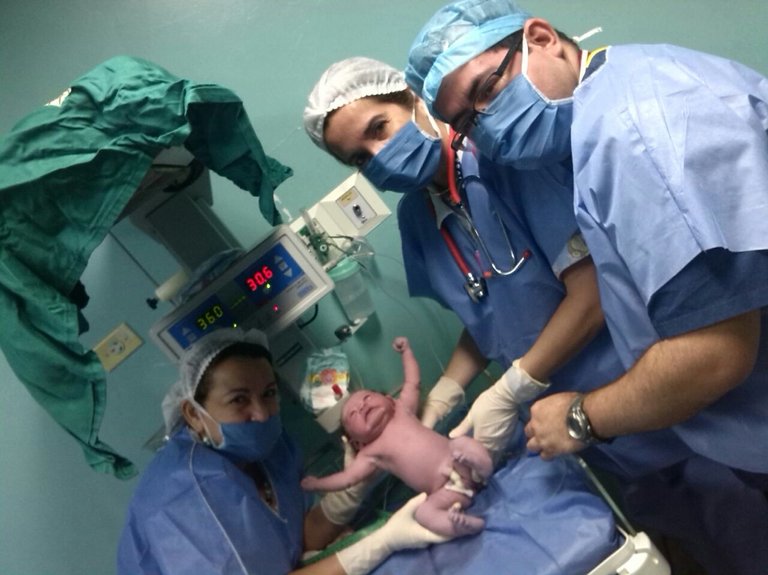
Once the birth occurs, the newborn must adapt to the extrauterine environment and we as health providers must act in a timely manner providing essential care to avoid complications that may compromise the life of the newborn.
Within these cares we have the challenge of maintaining a temperature in the newborn equal to or more similar to the body (37 degrees Celsius), since the delivery rooms are environments with low temperatures to maintain microbiological control.
The human body before any external agent that can modify its normal functioning, acts with regulatory mechanisms as a compensatory physiological response, that is why the newborn at birth has brown fat to help regulate its body temperature and avoid sudden changes or a hypothermia that seriously compromises the life of the newborn.
The Brown Fat.
It is a special fatty tissue that produces a lot of heat through different chemical reactions, which helps the newborn to adapt to the extrauterine environment once the birth is given, thus counteracting sudden temperature changes.
> Brown fat is found in various parts of the baby's body and, when metabolized, passes into the blood vessels by heating the entire body.
The Skin of Newborns.
From an anatomical point of view, it is very thin, which makes it very susceptible to changes and has little subcutaneous fat. The blood vessels that supply it are very close to the skin, which helps it lose heat easily.
For a newborn it is a very abrupt change from the intrauterine environment, where they are so comfortable, with an adequate temperature, to the extrauterine environment and even more to the cold delivery room.
The organism needs to maintain a thermal balance and this occurs when a relationship between production and heat loss is maintained, this process can be called thermal homeostasis.
> Heat production in the newborn has two components.
Non-thermoregulatory thermogenesis.
This occurs due to basal metabolism, motor activity and thermal action of food. For example, when the temperature decreases in the newborn, the energy activity of the organism is activated to produce heat and balance the temperature.
Thermoregulatory thermogenesis.
Chemical thermogenesis, mechanism of brown fat or thermal stress.
For example, when the newborn is under cold stress, the central body temperature is normal at the beginning but this generates a great energy cost and when this energy source decreases the ability to maintain normal body temperature is lost, and the newborn falls in hypothermia
In the Image presented below we can see the Primary Physiological Responses of the Newborn Undergoing Cold Stress, until reaching the production of Brown Fat, but it is important to emphasize that this event can be prolonged and lead to the appearance of hypothermia proper.
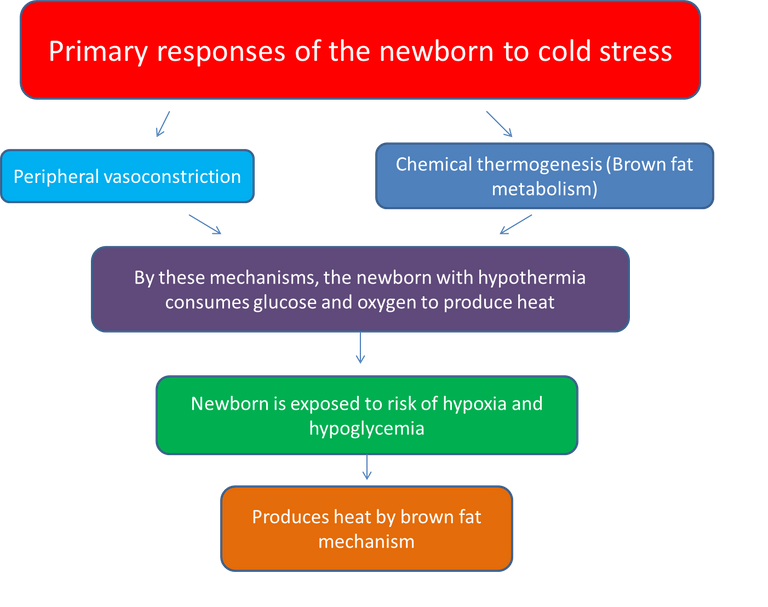
> In the newborn, the ability to produce heat is limited and the loss mechanisms may be increased, depending on the gestational age and care at birth and the period of adaptation.
Thermoregulation is a physiological function that the newborn has to face extrauterine life, and it is to maintain a balance between production and heat loss so that the body temperature is within a certain normal range, if the opposite occurs they leave To present a series of causes that compromise the life of the newborn, which can end in a neonatal intensive care unit, that is why the possible effects that can occur are presented below.
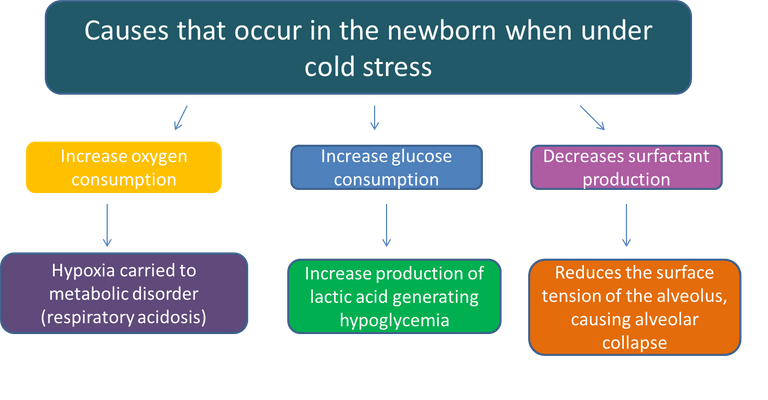
Normal Temperature Values in Newborn at Term.
one. Central body temperature : ( Rectal temperature).
Normal value is 36.5 - 37.5 ° C.
two. Skin temperature: (Axillary temperature).
Normal Value is 36.0 -36.5 ° C.
Classification of Hypothermia.
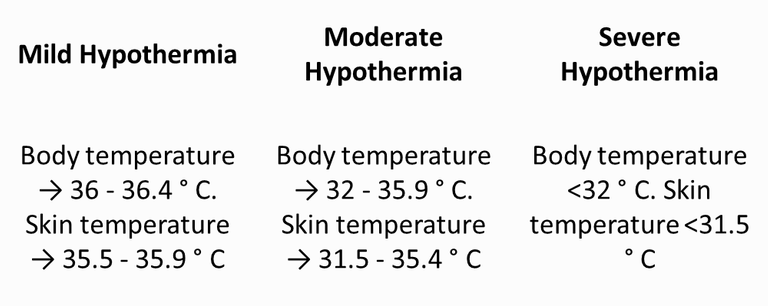
In the newborn, the ability to produce heat is limited, which is why the classification of hypothermia is shown.
Heat Loss and Gain Mechanism.
1. Driving.
When the newborn comes into contact with objects (scales, mattresses, radiological plates and stethoscopes), it can gain or lose heat depending on the temperature they present.
2. Convection.
Circulation of cold or hot air to an exposed area of the newborn, exposes it to present loss or gain of body heat.
3. Evaporation.
When the skin of the newborn is damp and is not very dry, through evaporation it can gain or lose heat.
4. Radiation.
Loss of body heat towards a colder object that is not in direct contact with the child.
Factors Predisposing Thermoregulation in the Newborn
- Gestational age.
- Hypoxia and hypoglycemia.
- Congenital anomalies.
- Damage of the central nervous system.
- Intrauterine growth retardation.
- Sedation.
- Motor and muscle tone decreased.
Signs of Hypothermia
Cold body to the touch, Cyanosis, Respiratory difficulty, Apnea, Tachypnea, Oral intolerance, Abdominal distension, Bradycardia, Peripheral poor perfusion, Decreased activity, Decreased reflexes, Hypotonia, Weak crying, Weak suction, Hypoglycemia
Signs of Hyperthermia
Tachypnea, Apnea , Tachycardia, Hypotension, Flushing, Hot extremities, Irritability, Lethargy, Hypotonia, Extensive posture, Weak or absent crying, Skin temperature greater than 38 degrees Celsius.
Nursing Preventive Actions.
- Assess the temperature of objects that come into contact with the newborn - preheat.
- Avoid drafts.
- Heat oxygen and aerosols
- Hygiene of the newborn with water under controlled temperature.
- The skin keep it dry.
- Use of incubator if necessary.
- Heat and humidify breathed gases.
- Prevent closeness with colder objects.
- Interpose elements that prevent loss of temperature in the newborn.
- Preheat the incubator before introducing the child.
- Avoid incubators near doors, windows and air conditioning that cools your walls.
The Use of the Incubator to Avoid Hypothermia.
Currently there are incubators that provide the temperature that one wants the newborn to have in its external environment, programmed on the monitor by the operator, in turn these act automatically through a sensor that goes to the skin of the newborn born and according to the baby's body temperature the ambient temperature decreases or increases, for an ideal operation of these devices is to monitor the level of water that is added to humidify the ambient air and change the filters every certain hours of use as established by the manufacturer.
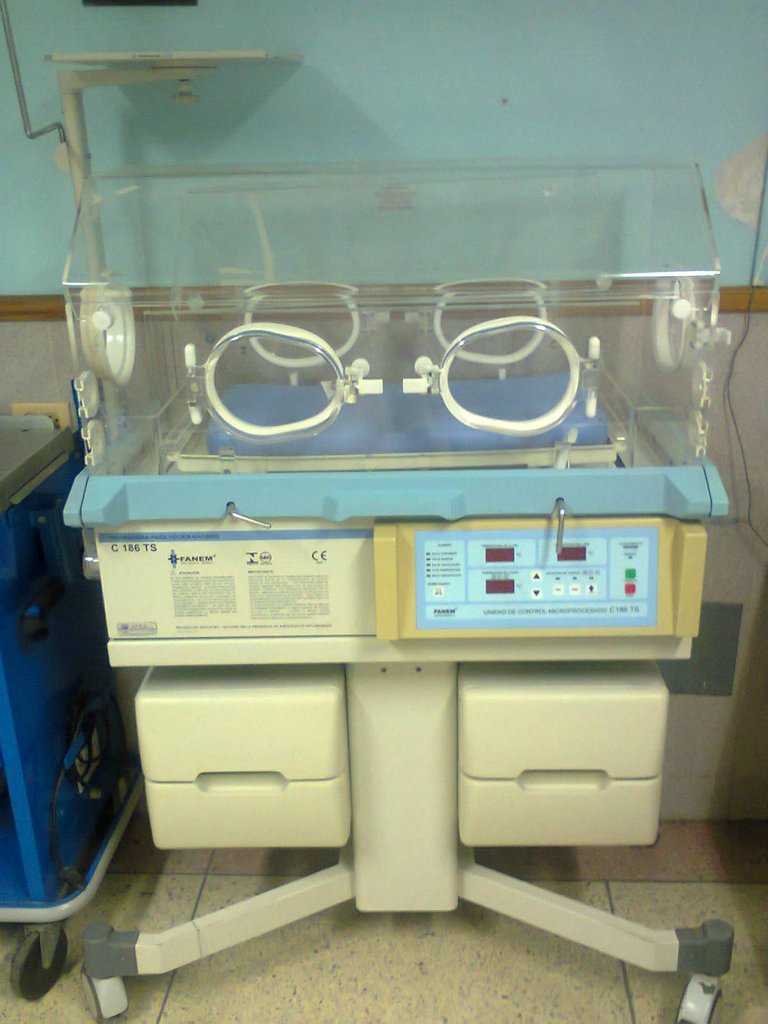
He wrote for you the Lcdo. Félix Arnaldo Rodríguez Díaz @Felixrodriguez
References Cited
Nursing knowledge of essential maternal
This post has been voted on by the SteemSTEM curation team and voting trail. It is elligible for support from @curie and @minnowbooster.
If you appreciate the work we are doing, then consider supporting our witness @stem.witness. Additional witness support to the curie witness would be appreciated as well.
For additional information please join us on the SteemSTEM discord and to get to know the rest of the community!
Thanks for having used the steemstem.io app and included @steemstem in the list of beneficiaries of this post. This granted you a stronger support from SteemSTEM.